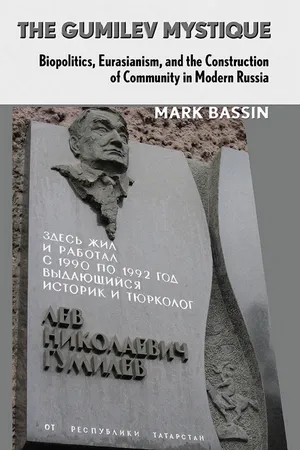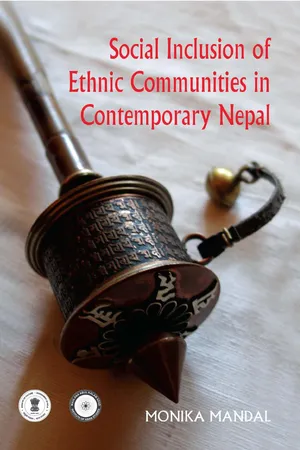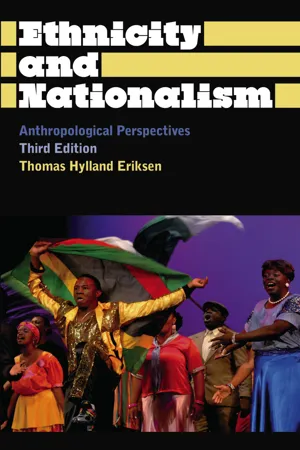History
Ethnogenesis
Ethnogenesis refers to the process through which distinct ethnic groups are formed, often involving the merging of different cultural, linguistic, and social elements. This concept is significant in understanding the development and evolution of various ethnic identities and communities over time. Ethnogenesis can be influenced by factors such as migration, intermarriage, and interactions with other groups.
Written by Perlego with AI-assistance
Related key terms
4 Key excerpts on "Ethnogenesis"
- eBook - ePub
Culture and Society after Socialism
Biopolitics, Eurasianism, and the Construction of Community in Modern Russia
- Mark Bassin(Author)
- 2016(Publication Date)
- Cornell University Press(Publisher)
82Over much of their life histories, Gumilev maintained, ethno-organisms remained dependent on their respective geographical environments. Landscape acted to condition the ethnos in its earliest stage, in the sense that the process of Ethnogenesis itself could only be initiated in regions that possessed significant landscape variability.83 Certain geographical regions offered more favorable conditions for Ethnogenesis, a point Gumilev illustrated through complex maps and tables correlating landscape zones to specific incidences of Ethnogenesis in history.84 Ethnogenesis had occurred at a rapid rate in Europe—where there was a great variety of contrasting landscape types—and much more slowly in Central Asia.85 And from the moment of their emergence as discrete entities, ethnies were compelled to adapt to the geographical conditions they encountered. This was “above all a process of active adaptation (adaptatsiia ) of human collectives in a milieu—ethnic and natural—in the course of which the landscape compels people to develop complex adaptive skills, that is, ethnic behavioral stereotypes. Consequently, the unique combination of landscapes in which a given ethnos originated determines (opredeliaet ) its distinctive character—behavioral and even in many respects cultural.”86 The most important evidence for this was the behavioral stereotype itself, a bundle of reflexes shaped by external environmental influences and passed down through the generations, which enabled the ethnos to sustain itself in a similar environment over its entire life history.87Ultimately, ethnic diversity itself was a product of the ecological dependency of ethnies on the landscape. The differences that set ethnies apart “reflect the deep ties between a human population and the surrounding landscape, which comprises an area for habitation, provides food, and even shapes aesthetic and moral values.”88 Precisely because geographical landscapes themselves are so different across the globe, “the biocenoses they support are unique, and thus the respective forms of adaptation in each one must be different.”89 In all of this, Gumilev saw a basic biological principle at work. Adaptation to external geographical conditions was a method deployed by all organisms in order better to meet their evolutionary tasks of survival and reproduction. Because humankind is in principle able to live in such a wide variety of environments, the adaptive challenges it faces are uniquely complex and diversified. The division of homo sapiens into ethnic groups, Gumilev suggested, was essentially a response to this challenge, that is to say, a natural species strategy for survival. As discrete ethnies, each with its own adaptive response to the unique conditions of the particular geographical landscape it occupies, the chances for sustaining its existence and enhancing its welfare are maximized, for each individual group and for the species as a whole. The fact that this adaptation was “in the behavior and not the [genetic] structure” of the ethnic groupings in no way altered its character as a biological mechanism as far as Gumilev was concerned.90 - (Author)
- 2013(Publication Date)
- KW Publishers(Publisher)
The second stage in the transformation of ethnic groups involved the articulation and acquisition of social, economic, and political rights for the members of the group or the group as a whole. Depending upon the perceived needs and demands of the groups, its size and distribution, its relations with other groups, and the political context, demands may aim at relatively modest civil, educational, and political rights and opportunities for the individual members of the group or for recognition of the group’s corporate existence as a political body or nationality. Insofar as an ethnic group succeeds by its own efforts in achieving and maintaining group rights through political action and political mobilisation, it has gone beyond ethnicity to establish itself as a nationality.Conceptualisations to EthnicityThe developments of ‘ethnicity’ are not only empirically very varied; they are characterised by contradiction in terms. On the one hand, we encounter highly durable ethnies , some of them indeed tracing their origins over several centuries, even millennia. On the other hand, we observe the rise of new ethnies and the dissolution of older ones, as well as the many transformations of culture that existing ethnies have undergone. Moreover, as we come closer to the object of investigation, we discern the many fissures in ethnies and shifts in ethnic identification; the literature is full of examples of ‘multiple identity’, which include not only the many different affiliations of individuals with other kinds of grouping such as gender, region, class, religion, and the link, but also the many shifting identifications between different ethnies or ethnic categories. In ancient Greece, for example, one could identify with one’s polis with one’s ethno-linguistic group, or with one’s ethnie. In modern Nigeria, one can identify with one’s clan, one’s ethnie, one’s religious community, and with the national state of Nigeria, not to mention with African culture.We can divide the existing approaches to ‘ethnicity’ into two broad camps, and a number of alternative approaches. First come the so-called ‘primordialists’. This term was first used by Edward Shils, who was influenced by his reading in the sociology of religion. He sought to distinguish certain kinds of social bond—personal, primordial, sacred, and civil ties—and to show how even in modern, civic societies the other kinds of social bonding persisted.16 It was an idea taken up by Clifford Geertz, who spoke of the ‘overpowering’ and ‘ineffable quality’ attaching to certain kinds of tie, which the participants tended to see as exterior, coercive, and ‘given’. It is important to note here that ‘primordiality’ is attributed by individuals to the ties of religion, blood race, language, region, and custom; it does not inhere in these bonds. Geertz suggests that the drive for an efficient, dynamic modern state interacts with the other great drive for personal identity, which is based on the ‘primordial ties’.17- eBook - ePub
Ethnicity, Nationalism and Conflict in the South Caucasus
Nagorno-Karabakh and the Legacy of Soviet Nationalities Policy
- Ohannes Geukjian(Author)
- 2016(Publication Date)
- Routledge(Publisher)
Chapter 2The Ethnic Past and Myths of Ethnogenesis in Transcaucasia
The examination of the ethnic past and Ethnogenesis (that is, the formation) of the Armenian and Azerbaijani nations requires an investigation and emphasis on their myths or origin, their values, their symbols, their rituals, the wanderings of their ethnic communities, and their liberation from alien rule and unification. In addition, it requires an account of the foundation of their polities (if any) and mainly their myths of a golden age (that is, their collective achievements in the religious, military and economic fields) that functioned to satisfy their quest for authentic identity. The golden age also functioned to locate and re-root their communities in their own historic and fertile space. The significance here was to tell the members of their nations that they had a homeland with ‘definitive historical and clear geographical dimensions’.1 The homeland was the land of the ancestors in which national heroes had created a golden age for the nation.To locate the homeland of both nations requires a careful examination of their formation in all epochs of history. From a perennialist standpoint, a nation is defined in terms of its ethnicity, religious culture and vernacular language. This depiction of the nation perhaps makes it easier to endorse the ideas of nations before nationalism and nations before modernity. While continuous perennialism asserts that the roots of particular nations can be traced back to the Middle Ages, and in a few cases antiquity, recurrent perennialism stresses that the recurrence of the same type of nations or the cultural identities may be traced in varied ways in different historical periods. According to Anthony Smith, the Jews, in the first century BC and the Armenians in the fifth century BCE are good examples of this recurrent phenomenon. Similarly, Steven Grosby compared the ancient Jews to the ancient Greeks, Egyptians and Armenians on the basis of their collective cultural identities as nations so as to stress the ‘primordial’ relationship of a people to its land.2 - eBook - ePub
Ethnicity and Nationalism
Anthropological Perspectives
- Thomas Hylland Eriksen(Author)
- 2010(Publication Date)
- Pluto Press(Publisher)
The terminological switch from ‘tribe’ to ‘ethnic group’ may also mitigate or even transcend an ethnocentric or Eurocentric bias which anthropologists have often been accused of promoting covertly (most famously, perhaps, by Said, 1978). When we talk of tribes, we implicitly introduce a sharp, qualitative distinction between ourselves and the people we study; the distinction generally corresponds to the distinction between modern and traditional or so-called primitive societies. If we instead talk of ethnic groups or categories, such a sharp distinction becomes difficult to maintain. Virtually every human being belongs to an ethnic group, whether he or she lives in Europe, Melanesia or Central America, although the significance of their ethnic membership is bound to vary. There are ethnic groups in English cities, in the Bolivian countryside and in the New Guinea highlands. Anthropologists themselves belong to ethnic groups or nations. Moreover, the concepts and models used in the study of ethnicity can be applied to modern as well as non-modern contexts, to North Atlantic as well as Asian or African societies. In this sense, the concept of ethnicity can be said to bridge two important gaps in social anthropology: it entails a focus on dynamics rather than statics, and it relativises the boundaries between ‘Us’ and ‘Them’, between moderns and tribals (see also Jenkins, 2008: chapter 2).SO WHAT IS ETHNICITY? When we talk of ethnicity, we indicate that groups and identities have developed in mutual contact rather than in isolation. But what is the nature of such groups?When A.L. Kroeber and Clyde Kluckhohn investigated the various meanings of ‘culture’ in the early 1950s (Kroeber and Kluckhohn, 1952), they identified 162 different definitions. Most of those who write on ethnicity do not bother to define the term, and the actual usages of the term vary. Instead of going through the various definitions of ethnicity here, I will point out significant differences between analytical perspectives as we go along. As a starting point, let us examine the recent development of the term as it is used by social anthropologists.The term ‘ethnic group’ has come to mean something like ‘a people’. But what is ‘a people’? Does the non-immigrant population of Britain constitute a people, does it comprise several peoples (as Nairn, 1977, argued), or does it rather form part of a Germanic, or an English-speaking, or an Atlantic, or a European people? All of these positions may have their defenders, and this very ambiguity in the designation of peoples has been taken on as a challenge by anthropologists. In a pioneering study of ethnic relations in Thailand, Michael Moerman (1965) asked, rhetorically: ‘Who are the Lue?’ The Lue were the ethnic group his research focused on, but when he tried to describe who they were – in what ways they were distinctive from other ethnic groups – he quickly encountered problems. His problem, a very common one in contemporary anthropology, concerned the boundaries of the group. After listing a number of criteria commonly used by anthropologists to demarcate cultural groups, such as language, political organisation and territorial contiguity, he states: ‘Since language, culture, political organization, etc., do not correlate completely, the units delimited by one criterion do not coincide with the units delimited by another’ (Moerman, 1965: 1215). When he asked individual Lue what were their typical characteristics, they would mention cultural traits which they in fact shared with other, neighbouring groups. They lived in close interaction with other groups in the area; they had no exclusive livelihood, no exclusive language, no exclusive customs, no exclusive religion. Why was it appropriate to describe them as an ethnic group? After posing these problems, Moerman was forced to conclude that ‘[s]omeone is Lue by virtue of believing and calling himself Lue and of acting in ways that validate his Lueness’ (1965: 1219). Being unable to argue that this ‘Lueness’ can be defined with reference to objective cultural features or clear-cut boundaries, Moerman defines it as an emic category of ascription
Index pages curate the most relevant extracts from our library of academic textbooks. They’ve been created using an in-house natural language model (NLM), each adding context and meaning to key research topics.



